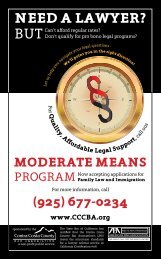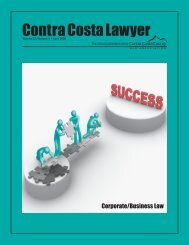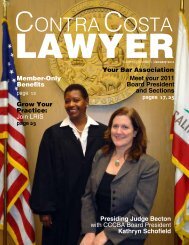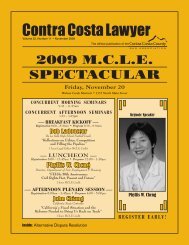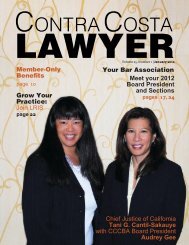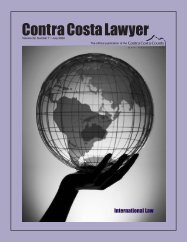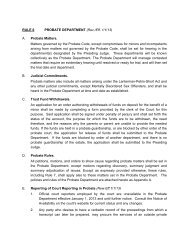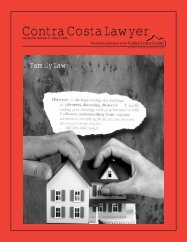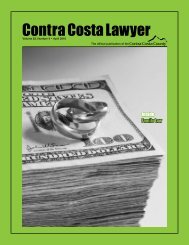download - Contra Costa County Bar Association
download - Contra Costa County Bar Association
download - Contra Costa County Bar Association
Create successful ePaper yourself
Turn your PDF publications into a flip-book with our unique Google optimized e-Paper software.
inns of court<br />
by Matthew Talbot<br />
On January 11, 2013, Judge<br />
Craddick’s group (consisting<br />
of Jeremy Seymour,<br />
Nataly DiCortossa, Alison<br />
Chandler, David Marchiano, Heidi<br />
Coad-Hermelin, Harry Styron, Joseph<br />
Ryan, Matthew Guichard and<br />
Ralph Zappala) provided the educational<br />
presentation at the Robert<br />
G. McGrath Inns Of Court Meeting.<br />
Their presentation was about electronic<br />
discovery. It is often said<br />
(mostly by me) that discovery fights<br />
are the bane of every attorney’s existence.<br />
Nothing in this presentation<br />
helped dissuade me from that<br />
outlook. Even UFC fighters think<br />
discovery fights are too primitive<br />
and brutal. Technology has only<br />
complicated discovery in ways that<br />
few could have anticipated. The<br />
bottom line of the presentation was<br />
“never use technology ever.”<br />
First, Alison Chandler and Jeremy<br />
Seymour used a photo of Judge<br />
Craddick uploaded to Flickr to discuss<br />
meta-data. Meta-data is all<br />
the background information about<br />
electronic items (such as digital<br />
photos) that few ever pay attention<br />
to. They discussed how the iPhone<br />
tracks everything it does and everywhere<br />
it goes. This information can<br />
be discoverable and you might not<br />
have even known that it existed.<br />
The discussion next flowed to providing<br />
the electronically stored information<br />
(ESI). Federal Rule Of Civil<br />
Procedure 26(b)(2)(B) notes that<br />
you don’t have to provide the ESI<br />
if it is not easily accessible because<br />
of burden or cost. Nataly DiCortossa<br />
and Ralph Zappala discussed the<br />
enforcement of this rule. You can<br />
bring motions for a protective order<br />
or to compel discovery. These<br />
motions are generally a delightful<br />
experience not filled with minutiae<br />
regarding what constitutes an undue<br />
burden. Or the exact opposite of<br />
that sentence.<br />
The discussion flowed to setting<br />
up a Discovery Plan for the court<br />
if you end up in the middle of an<br />
ESI discovery fight. Additionally,<br />
the group discussed the duty to preserve<br />
ESI. You do not have a duty to<br />
preserve every piece of electronic<br />
information. If you have a standard<br />
policy (such as deleting ESI every<br />
90 days), it is appropriate. However,<br />
deleting ESI specifically to avoid<br />
discovery is about as big a no-no as<br />
you can get. Unless you slap your<br />
opposing counsel about the face<br />
and neck with a stack of document<br />
requests. And negligent destruction<br />
can even lead to sanctions. So, don’t<br />
leave all of your hard drives on the<br />
furnace during the winter.<br />
Matt Guichard and David Marchiano<br />
then focused on the protective<br />
orders. They discussed drafting<br />
them, including Liquidated Damages<br />
Clauses in the Protective Orders<br />
themselves. The conversation<br />
flowed to methods of production.<br />
Electronic discovery can include<br />
thousands or even millions of documents.<br />
It could easily overwhelm a<br />
smaller law firm. One way to assist<br />
with electronic discovery is to hire<br />
a vendor to organize the discovery.<br />
You can use in-house attorneys<br />
if you are a big enough firm, but<br />
32<br />
MARCH 2013



